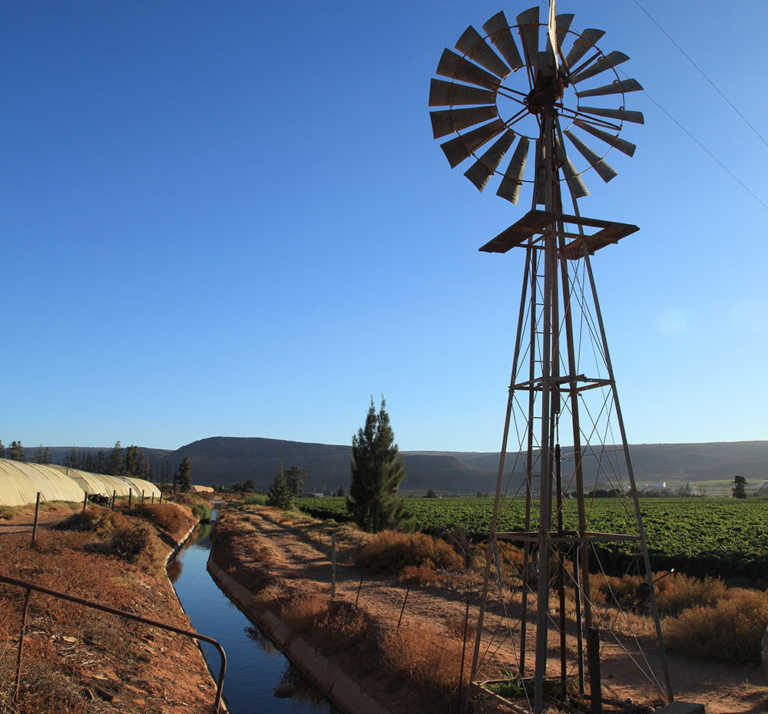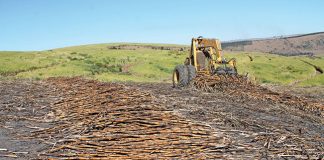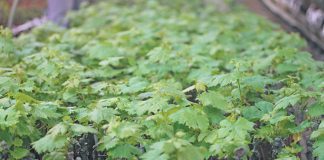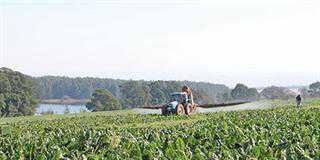
In January this year, producers in the Lower Olifants River had access to only about half their water quota. What happened?
A break occurred in the irrigation canal on 7 January. The canal runs at full capacity at this time of year, with a freeboard (the vertical distance between the water surface and the crest of the embankment) of less than 50mm in some places. The tiniest rise in water level could cause an overflow.
During the most recent incident, the canal overflowed and water washed away soil supporting the concrete lining, causing the lining and two of the panels to collapse. An 18m stretch of the canal had to be replaced entirely and about 250 000m³ of water were lost in the process.
How did the break affect producers?
A shortage of water at this time of year could be catastrophic for producers. The Lower Olifants River Water Users’ Association aims to reroute the water supply within five days of a break. We generally try to divert at least 50% of the water past the break.
This time, we managed to meet 70% of the irrigation demand.
We installed a temporary steel structure to reroute the water, which allowed the contractor to repair the concrete wall while still allowing the water to run. The normal flow was restored when this structure was removed during the first week of February.
It seems as if breaks occur in the canal almost every year. Why is this?
The concrete used has a lower water-cement ratio to allow for a consistency that can be placed on a sloping surface. After eighty years of usage, the concrete has become frail and prone to damage.
The idea of the irrigation canal was conceived in about 1875, but it was only after the Second Anglo-Boer War ended in 1902 that design and construction started.
At first, only the Bulshoek Dam was built, but in 1935 the Clanwilliam Dam was built to add storage capacity. In 1969, this dam wall was raised to further increase storage capacity. Efforts are now again in progress to increase the capacity of the Clanwilliam Dam.
Breaks have occurred in the canal in 2000, 2008, 2010 (after 172mm of rain fell in Lutzville), 2015 and 2017. In 2010, the canal wall was breached in seven separate places, and in 2015 a 180m-long break occurred in the soil supporting the concrete lining.
The most recent break was the first on the main canal, which means that it affected all the irrigators, municipalities and industries drawing water from it.
Who is responsible for the upkeep and maintenance of the canal?
The Lower Olifants River Water Users’ Association is responsible for the general operation and maintenance of the canal. The upgrading and refurbishment of the canal, including repair of major breaks, are the responsibility of the Department of Water Affairs and Forestry (DWAF).
What is the canal’s distribution area?
The main canal extends for 260km and has side-branches totalling a further 60km. It supplies water to the Bulshoek Dam near Rondeberg, as well as to farmers from Koekenaap to Ebenhaeser.
Does the canal still meet the demands of the farming community?
This is a dry area with an average rainfall of 160mm/ year. Every drop of water is treated with respect. The area has water rights to irrigate 9 510ha of land, but the water allocation is spread over 15 000ha of land.
In the past, DWAF allocated more water for irrigation than the canal’s capacity allowed.
Initially, water was used for flood irrigation of lucerne lands, but today it is primarily used to irrigate vegetables, wine grapes and grapes used for raisins.
The region still has a steady supply of good quality arable land that can be used for production expansion, but water supply is a problem. Our greatest demand for water is from September to March.
Despite 12 200m³ water/ ha/ year having been allocated to the area, we have access to only 8 400m³/ha during a good rainy season. The capacity of the canal is the biggest restraint.
Government’s agreement to enlarge the Clanwilliam Dam includes an upgrade of the canal. However, achieving greater storage capacity for the dam without ensuring that the canal is able to distribute the water to users would benefit no one. It will cost about R4 billion to rebuild or upgrade the canal.
How did last year’s drought affect the situation?
Due to reduced rainfall and water restrictions, we had access to only 5 100m³/ ha to irrigate permanent crops. Cash crops could not be planted and this had a highly negative impact on the cash flow of many farmers.
What progress has been made with the enlargement of the Clanwilliam Dam?
Negotiations about the upgrade of the Clanwilliam Dam started in about 2004, with the idea that work would start in 2008. However, the plans were only announced and accepted by Parliament three years ago.
Since then, a lot of work has taken place on infrastructure development, including the building of new roads, in the region. For example, the N7 national road had to be rerouted to prevent it from being submerged during the upgrading of the dam.
As far as I know, since all these projects have been completed, government is in the process of appointing a contractor for the dam’s upgrade, with the aim of finishing the project within the next four years.
Who will benefit from the dam’s increased capacity?
Firstly, water supply will be more secure. It is estimated that the increased capacity of the dam will improve the delivery potential to commercial producers by about 20%.
Water supply for irrigation during drier years will be more secure. Run-off into the river will also be increased, and this will help to sustain the ecology of the river.
In addition, there are plans afoot to set aside enough water to irrigate 3 500ha of land as part of a BEE initiative.
Would it take pressure off the canal if producers stored more water during winter?
Yes, producers are allowed to store up to 60% of their water allocation, provided they have permission from the Department of Environmental Affairs.
Most producers also have balance dams, from which water is diverted to the canal to be used for irrigating vineyards and plantations. The high cost of building larger dams is prohibitive for farmers. In addition, farms in the region are small, so dams take up valuable production land.
There is also a lot of red tape involved in building a dam and it can take up to five years to get approval to build a large dam with a capacity of more than 50 000m³.
Building more dams with a smaller capacity would help reduce pressure on the canal. We have requested permission to approve smaller dams at local level, but have had no feedback.
Won’t upgrading the canal make water unaffordable?
It will definitely increase the cost of water. However, we believe it is government’s responsibility to supply water infrastructure. The industry has created many jobs and government generates between R300 million and R600 million per year through excise taxes.
Farming input costs have increased greatly over the past few years. An increase in water tariffs would therefore have a very negative impact on farmers’ bottom line, especially on smaller irrigation farms, forcing many smaller producers out of business.
Email Johan Matthee at [email protected].













